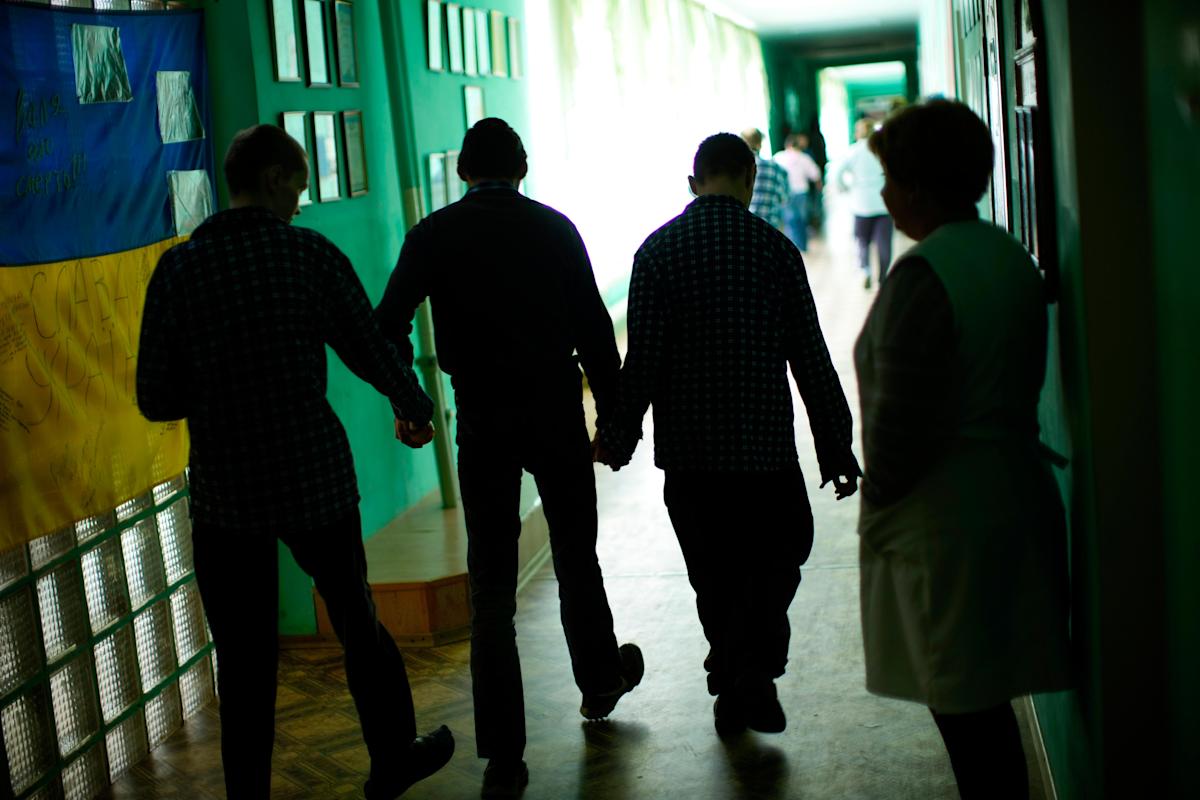
TAVRIISKE, Ukraine (AP) — There’s dancing in the garden, and ball games. A soft wind blows, cooling the spring sunshine. But there is an ominous accompaniment to the music and laughter: the unmistakable dull thud of not-so-distant artillery fire.
Still, the ball game goes on without interruption at the facility for mentally and physically disabled people in the village of Tavriiske, near the front line in Ukraine’s war. But it’s yet another reminder of the dilemma the staff face: Do they evacuate the facility, and how can it be done with minimum disruption to the residents, some of whom have very severe disabilities and others for whom changes in environment can be disorientating and highly stressful.
Then there’s the issue of where to go, and how. With around 425 residents, it is the largest such facility in Ukraine’s southeastern Zaporizhzhia region. Finding suitable accommodation elsewhere is far from easy, said director Oleksandr Starosvitskyi. Various options are being explored, including moving 250 residents to a regional psychiatric hospital, where beds are being prepared, and possibly also using a former orphanage.
Several meetings with regional authorities have already been held, and another is pending. But for Starosvitskyi, it is clear what should be done.
“This facility needs to be evacuated right away,” he said, stressing that its residents include many elderly and severely disabled people who cannot be moved easily or quickly. It would take about two days to get everyone out, depending how many transportation facilities are provided, he said.
Orikhiv, a neighboring village about 10 kilometers (six miles) to the south, is frequently shelled by Russian forces who invaded Ukraine in late February, and the war’s front line runs just beyond it. The southern part of the Zaporizhzhia region is now in Russian forces’ hands.
Starosvitskyi believes Tavriiske won’t be overrun. But the facility is still far too close to the front line for comfort. On Tuesday, a shell landed in the village for the first time. It fell in a field, causing no damage or injuries, and Starosvitskyi barely blinked at the sound of the explosion. But it was a stark reminder of just how close the war is.
Most of the facility’s residents are people who do not have families, but the relatives of those who do have been contacted and their consent sought for a potential evacuation, Starosvitskyi said. All have agreed.
While they await, staff have run air raid drills with those residents able to participate, taking them down to the bomb shelter. To those who can’t understand what’s going on, they’ve explained away the sounds of war as thunder.
The institution is spread among several buildings in the village. Before the war, one of the sections housing around 150 people would hold lively disco dances twice a week. “They all participated, they loved it,” said deputy director Liudmyla Melnyk.
But that stopped when the war started, for safety reasons. “We have really big loudspeakers, and we want to be able to hear what’s going on” in case they need to seek shelter, Melnyk explained. Now much smaller dances are held, with fewer people and the volume turned down.
“It’s scary to live under such a situation,” she said. “I never thought that in my lifetime I would live through a war.”
Other signs of the troubles beyond the institution’s walls have seeped in too. Among the brightly colored residents’ artwork decorating the spotless hallways is a poster about mine awareness. Some of the residents are knitting and sewing socks and other handicrafts for Ukraine’s soldiers.
But in general, staff try to ensure the conflict encroaches as little as possible, and much of daily life is unchanged. There are fiercely contested ping-pong games to play and drawing classes to attend, art projects to work on, pets to feed and the institution’s well-tended gardens to care for.
Some residents, however, understand what is happening.
“I’m a bit afraid,” said 19-year-old Maksym, who has cerebral palsy. “I would like this war to finish as soon as possible.”
Before the conflict, there was a chance he would begin studies under a program recommended by volunteers.
“I had a dream to be an actor,” said Maksym, who didn’t want to give his last name. He loves action movies, especially those with Jackie Chan and Bruce Lee, and has a pair of weights neatly laid out on his wheeled walking aid to help him work on his upper body strength.
But “everything changed” with the war, he said. “I wanted to go and study, I even planned it many times, and now I can’t go anywhere.”
Across the road another section houses mainly elderly people who cannot move from their beds. For them, accessing a bomb shelter is not an option.
“There is no possibility for that, not for these people,” Starosvitskyi said. “They need to be evacuated. This is the only way to save them.”
Borys Dudchenko, a disabled former soldier in the Soviet army, said he had “some fear, but everything else is OK.” Sitting in the garden with the sound of artillery in the background, he said he thought it best to evacuate.
But not all residents agreed.
One young woman who loves to play ping-pong and teach dance moves she learns on the internet to other residents, said she did not want to leave.
“I don’t want to move anywhere,” said Katya, who only gave her first name.
Inevitably, any evacuation would greatly affect the staff too, most of whom live locally. More than 200 people worked at the facility before the war, although about 100 people have left, the director said.
In his 18 years working at the institution, Starosvitskyi, a soft-spoken man with twinkling blue eyes, never thought he would have to protect his residents from war.
“Never, I could never even imagine this,” he said.
___
Associated Press journalist Inna Varenytsia contributed to this report.




